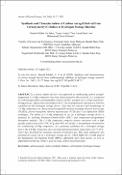Options
Synthesis and Characterisation of Carbon Aerogel Derived from Carboxymethyl Cellulose as Hydrogen Storage Material
Journal
Journal of Physical Science
Date Issued
2023
Author(s)
Ahmad Solehin Ab Sabar
Syaza Azhari
Nur Atiqah Nasir
Muhammad Zamir Othman
DOI
10.21315/jps2023.34.2.2
Abstract
A direct, simple and low-cost approach to synthesising carbon aerogelmagnesium (CA-Mg) composites has been demonstrated in this research. It is conducted by carbonising sodium carboxymethyl cellulose (CMC) aerogels via a sol-gel and freezedrying process. Mg is used as an enhancer for CA in the preparation step and as a selective candidate for the hydrogen storage device. Note that the structure and morphology of CA-Mg composites are characterised using field emission scanning electron microscopy (FESEM), fourier transforms infrared spectroscopy (FTIR) and X-ray diffraction (XRD) techniques. The ability of CA-Mg composites to act as a hydrogen storage device is analysed by utilising Brunauer-Emmett-Teller (BET) and temperature-programmed desorption analysis. The CA-Mg composites comprise porous structures with a high specific surface area of 101.4407 m2 /g, and 0.002 mol of Mg2+ is the optimum concentration for synthesising CA-Mg composites. As a potential candidate for a hydrogen storage device, the CA-Mg composites show an initial dehydrogenation temperature of 377.22°C, where they desorbed the maximum amount of hydrogen gas. This study emphasises the potential for using CA as a hydrogen storage device, which fulfils the seventh goal of
the Sustainable Development Goals (SDGs), affordable and clean energy, as well as Department of Energy (DOE)’s goal of using carbon-based materials.
the Sustainable Development Goals (SDGs), affordable and clean energy, as well as Department of Energy (DOE)’s goal of using carbon-based materials.
Subjects
File(s)
Loading...
Name
Synthesis and Characterisation of Carbon Aerogel Derived from Carboxymethyl Cellulose as Hydrogen Storage Material.pdf
Size
3.32 MB
Format
Adobe PDF
Checksum
(MD5):9460f6305b4c740f927e94ffee1fd5f2